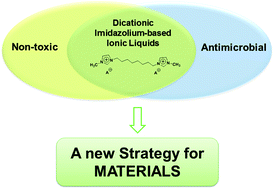Dicationic imidazolium-based ionic liquids: a new strategy for non-toxic and antimicrobial materials
Abstract
New dicationic imidazolium-based ionic liquids (ILs) were synthesized, characterized and tested in regards to cytotoxicity and antimicrobial activity. Insertion of a new cationic head and use of organic anions increased the biocompatibility of the ILs developed. IC50 (concentration necessary to inhibit 50% of enzymatic activity) values obtained were considerably higher than those described for monocationic ILs, which indicates an improvement in cytocompatibility. Antimicrobial activity against bacterial species of clinical relevance in wounds and the oral environment was tested. The results showed that ILs were effective in inhibiting bacterial growth even below the minimum inhibitory concentration (MIC). It was observed that structural features that confer higher hydrophobicity to ILs decreased both the IC50 and MIC simultaneously. However, it was possible to establish an equilibrium between those two effects, which gives the safe range of concentrations that ILs can be employed. The results demonstrated that the dicationic-imidazolium-based ILs synthesized may constitute a potent strategy for applications requiring non-toxic materials exhibiting antimicrobial activity.


 Please wait while we load your content...
Please wait while we load your content...